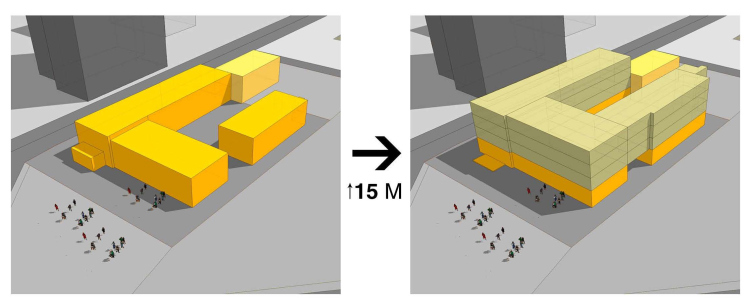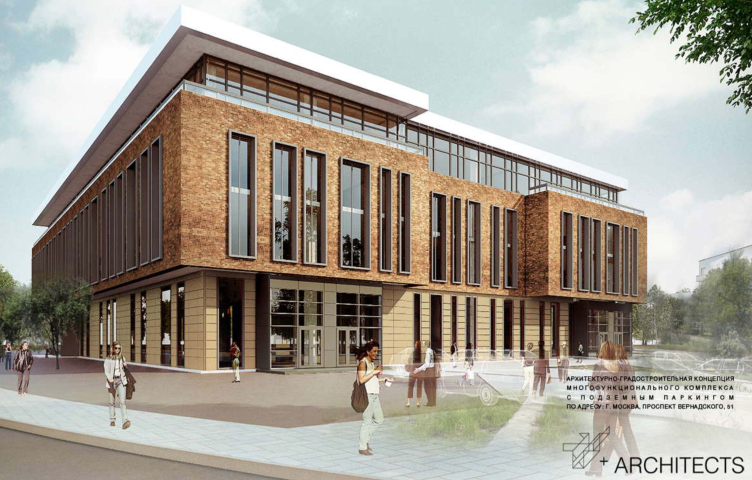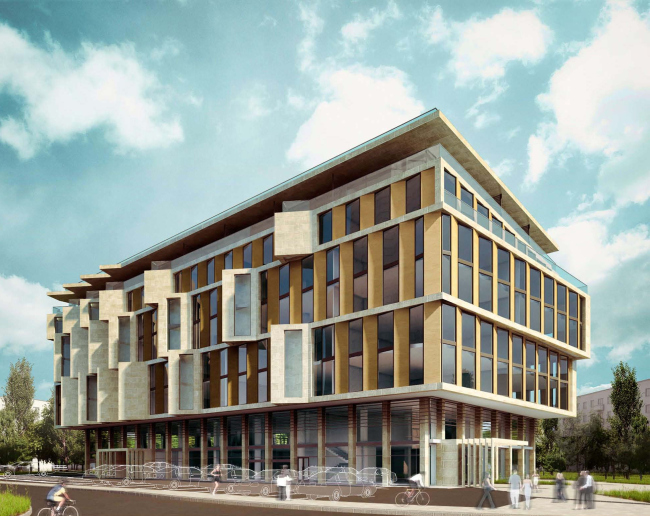
Preliminary architectural and planning concept of the multifunctional complex at the Vernadskogo Avenue © Т+Т Architects
The land site on which the architects plan to build the new multifunctional center is located in Moscow's southwest, not far away from "Prospekt Vernadskogo" metro station. The complex will "grow" in the depth of a residential block - one of its sides will be turned to a one-way street that leads directly to the Vernadskogo Avenue. The narrowness of the only available transport "artery" on the one side, and the walking accessibility on the other (the mere 500 meters' distance to the metro station) became for the architects the crucial factor in choosing the strategy for developing this land: before they even began to think whether they should take down the existing volume or whether they should reconstruct it, they realized that they were, in the first place, to create a developed public territory around it. Without such "side play", no matter what it would have looked like, the building would have blocked the neighborhood from the inside. Some certain restrictions on the designed volume were also imposed by the close vicinity of the residential high-rise on the other side of the driveway. The remaining distance between this building and the one in construction is 30 meters at the most, so this factor was impossible to ignore.
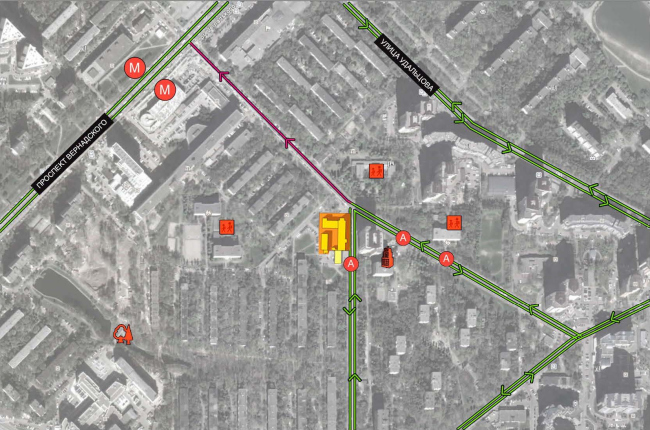
Preliminary architectural and planning concept of the multifunctional complex at the Vernadskogo Avenue © Т+Т Architects
Thus, with such "givens" - the necessity to create a well-organized public territory, take into consideration the existing pedestrian routes and the close vicinity to the high-rise - «T + T Architects" got down working on their project. And, before answering the question just what the new complex must look like, the architects were to decide whether to tear down the already standing three-story public and retail volume or whether to try and reconstruct it. Built in the late 1980's, this building is, of course, can by no means be considered an architectural monument, but it has definitely become an integral part of the life of the neighborhood, so, in order to weigh all the pro's and con's, the architects developed two concepts of developing this land site. In both of them, "T+T Architects" described in detail the factors that would influence the image and the subsequent functioning of the complex, depending on whether they would work with the existing building or build a new one from scratch.
Option 1. Execution Cannot Be. Pardoned.
The existing three-story volume is in fact the classic shopping center of a "local importance" that everybody who has at least once been in a sleeping-belt neighborhood can easily envisage. The building of a rather chaotic and asymmetric composition is literally stuffed with multiple little shops and services - it is of no esthetic value whatsoever but it sure is convenient for the people living in the surrounding houses. Opting for its reconstruction, the architects were to stay within the boundaries of the existing complex but they still had the opportunity to increase its height. However, simply putting a "slab" of the extra floor on top of the building would not do the job - in this case the volume would become too bulky and even more disorganized. This is why, in order to give it a more organized and well-proportioned look, the architects take a few drastic steps at once. First of all, they join together the two middle floors, giving the volume an easily readable tripartite structure. Then what they do is close the "double L" contour of not only the top floor but also the joint mid-levels, leaving an arch at the ground floor level. This gave the architects the opportunity not only to considerably increase the square footage of the building without breaching its boundaries on the first floor but also to create an inner courtyard inside the complex. The "intimate" character of the latter was also enhanced at the expense of the cantilever protrusions at the second-floor level, while the visual lightness is generally achieved by the floor-to-ceiling glazing of the top level that the architects "push inside" a tiny bit and then cover it with a graceful flat roof.

Preliminary architectural and planning concept of the multifunctional complex at the Vernadskogo Avenue © Т+Т Architects

Preliminary architectural and planning concept of the multifunctional complex at the Vernadskogo Avenue © Т+Т Architects
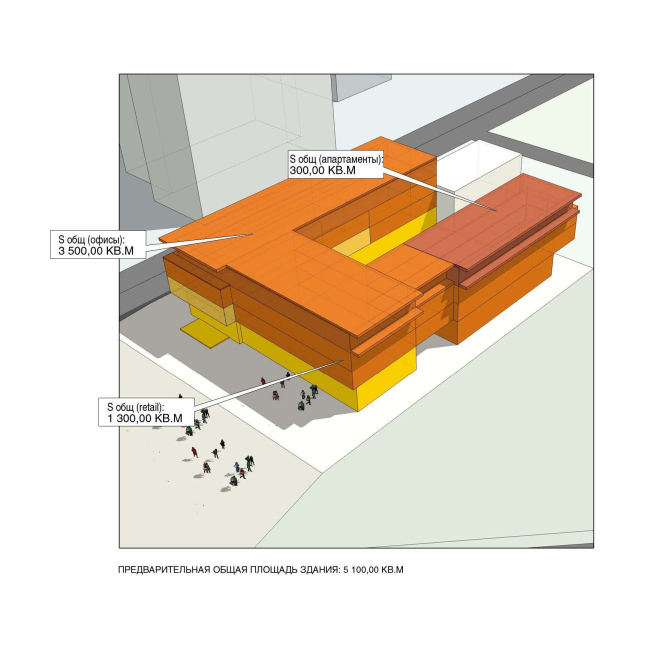
Preliminary architectural and planning concept of the multifunctional complex at the Vernadskogo Avenue © Т+Т Architects
Keeping the volume itself, the architects also carefully restore its main function - the social one. The first floor of the renewed building is given to the retail stores, services and a restaurant. The second floor gets a few offices that, of course, have separate entrances, while the third floor is completely dominated by them. And as for the flexible architecture, the architects gave it to the top fourth floor: it can include both offices and apartments, both being able to boast landscaped terrace roofs.
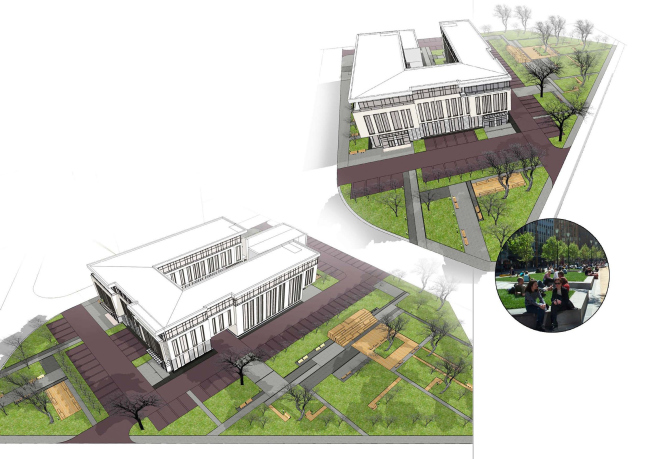
Preliminary architectural and planning concept of the multifunctional complex at the Vernadskogo Avenue © Т+Т Architects
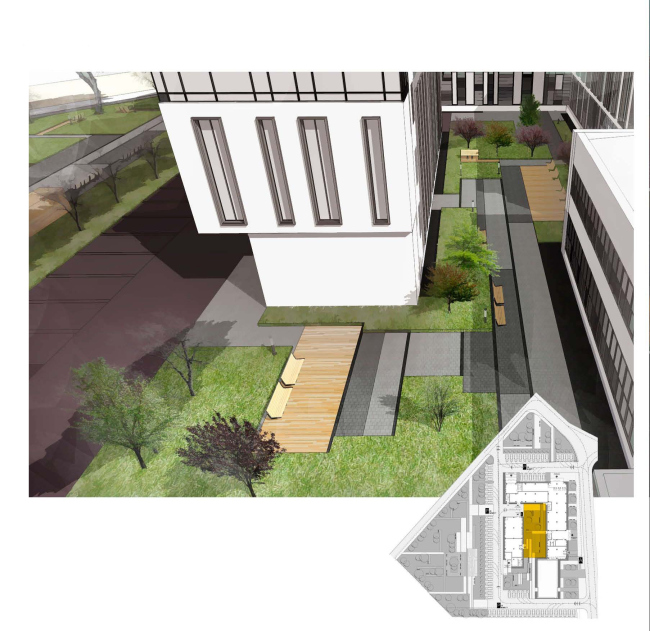
Preliminary architectural and planning concept of the multifunctional complex at the Vernadskogo Avenue © Т+Т Architects
And, as for the architectural design of the reconstructed volume, it is radically different from the original. "T+T Architects" do not leave even a trace of the concrete mumbo-jumbo of the late 1989's: their complex is strikingly elegant and can boast a memorable image capable of encompassing the ceramics of the warm creamy tone, and the textured brick, and the thin glitter of the glass, and the snow-white overhangs of the roof.
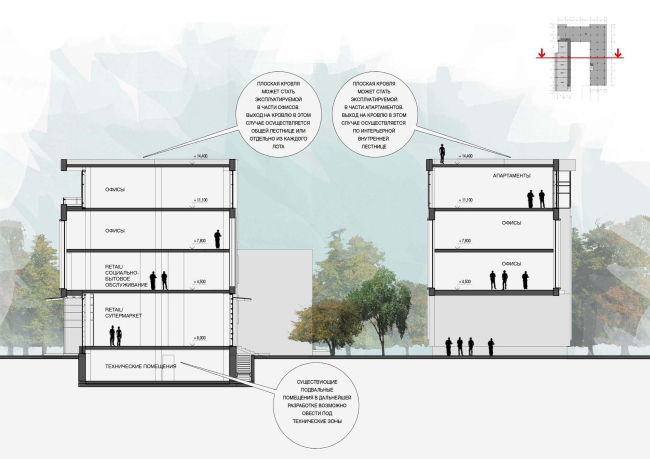
Preliminary architectural and planning concept of the multifunctional complex at the Vernadskogo Avenue © Т+Т Architects
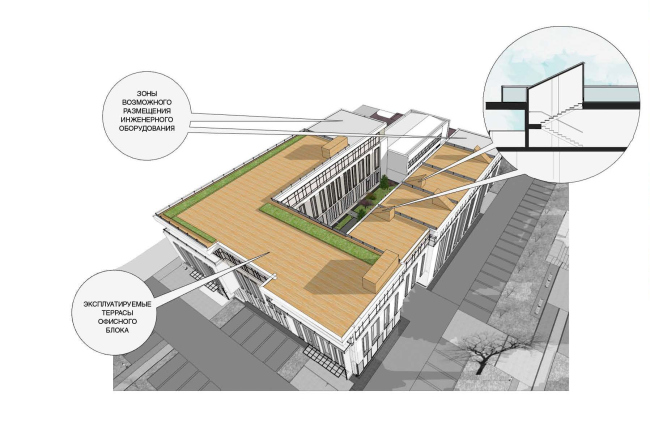
Preliminary architectural and planning concept of the multifunctional complex at the Vernadskogo Avenue © Т+Т Architects
Such a broad range of materials used helps to create the clear-cut "coding" of the facade - it takes a person but one glance to understand that this building has several functional blocks in it. And the most expressive one of them is definitely the central "office belt": the joint floors are "upholstered" with a textured hide of terra-cotta brick that gets slit by the tall window apertures accentuated by the rectangular frames of the window jambs.
Option 2. Execution. Cannot Be Pardoned.
Developing the "from-scratch" design, the architects started out with the parallelepiped, the parameters of which were determined by the maximum housing density and the maximum height - and then ran this parallelepiped through the context-induced deformations.
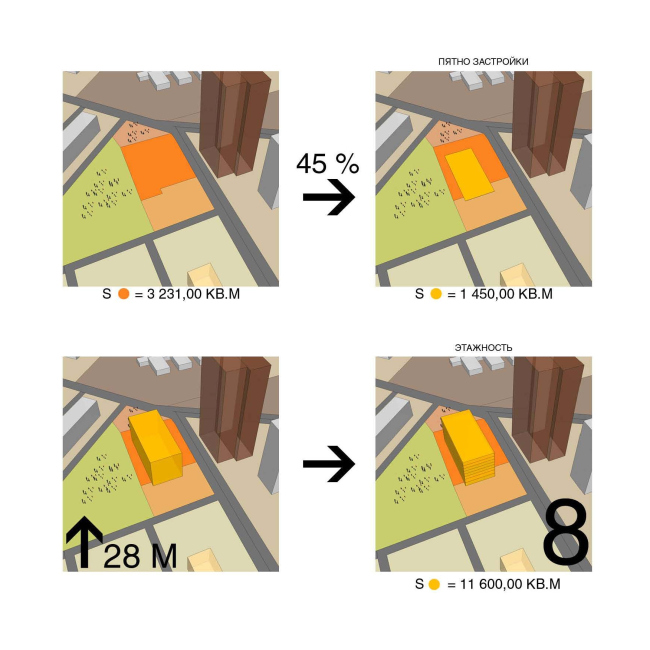
Preliminary architectural and planning concept of the multifunctional complex at the Vernadskogo Avenue © Т+Т Architects
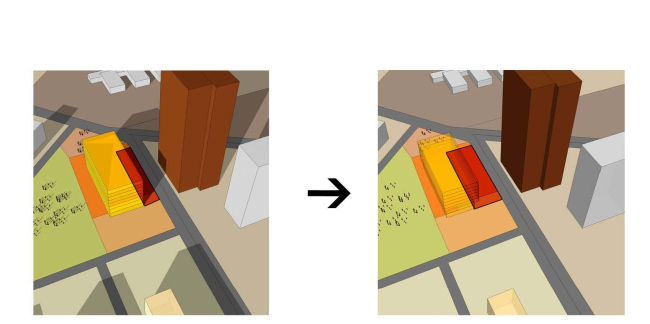
Preliminary architectural and planning concept of the multifunctional complex at the Vernadskogo Avenue © Т+Т Architects
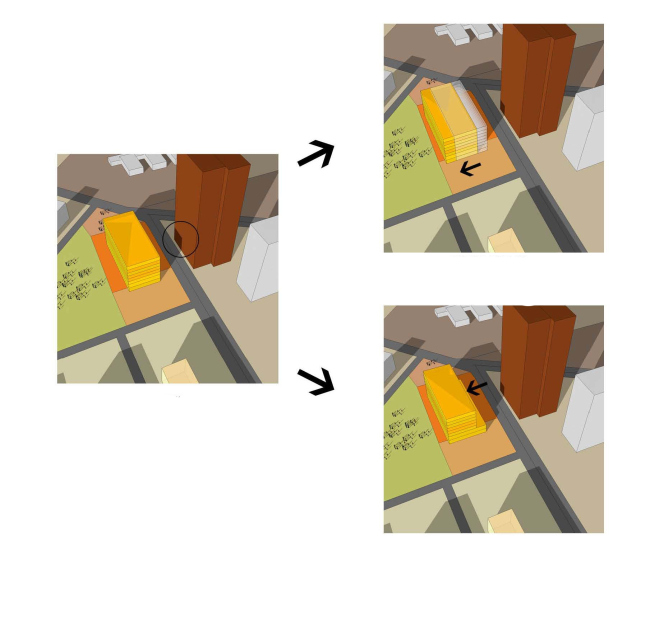
Preliminary architectural and planning concept of the multifunctional complex at the Vernadskogo Avenue © Т+Т Architects
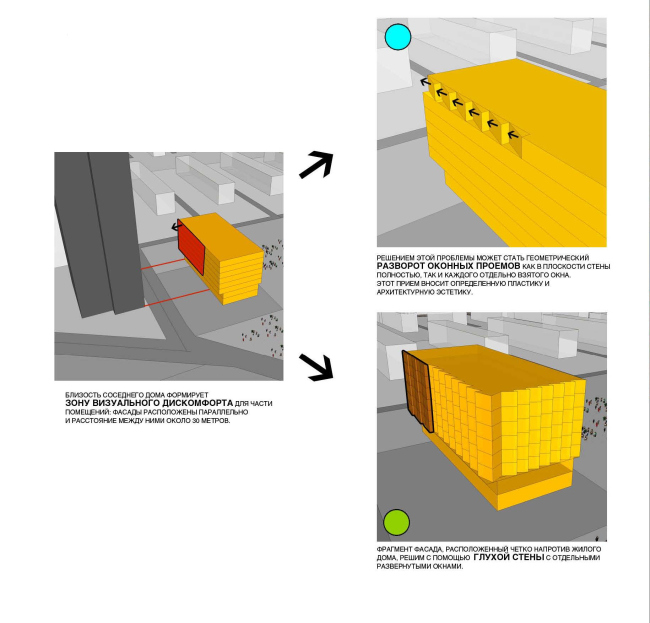
Preliminary architectural and planning concept of the multifunctional complex at the Vernadskogo Avenue © Т+Т Architects
First of all, they pushed it as far away as possible from the residential high-rise. Then the parallelepiped got a massive stylobate and a residential block, shifted again away from the residential building. However, because just as vital was the problem of creating a comfortable driveway into the territory of the complex, the architects, on the other side, pushed the stylobate deeper inside, making the cantilevers hand around the building's perimeter. At this point, one must acknowledge the fact that it did a lot of good to the volume surrounded by buildings on all sides: from a rather bulky (and sulky!) trunk it turned into a much more friendly-looking thing.
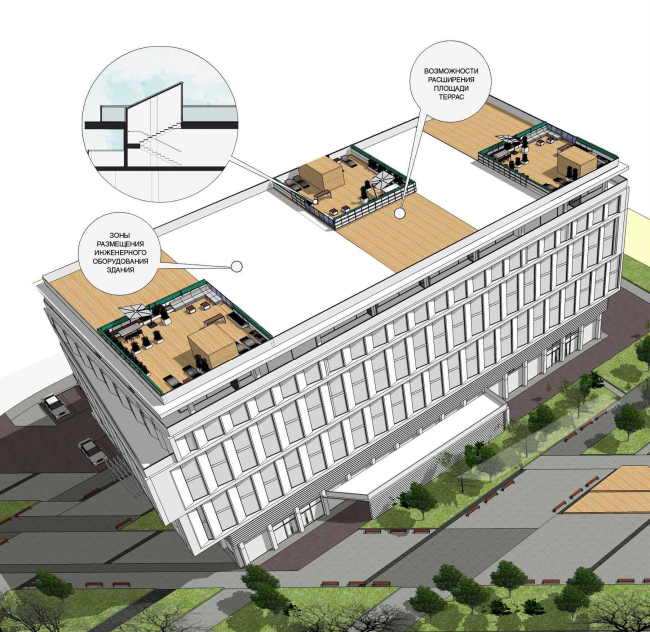
Preliminary architectural and planning concept of the multifunctional complex at the Vernadskogo Avenue © Т+Т Architects
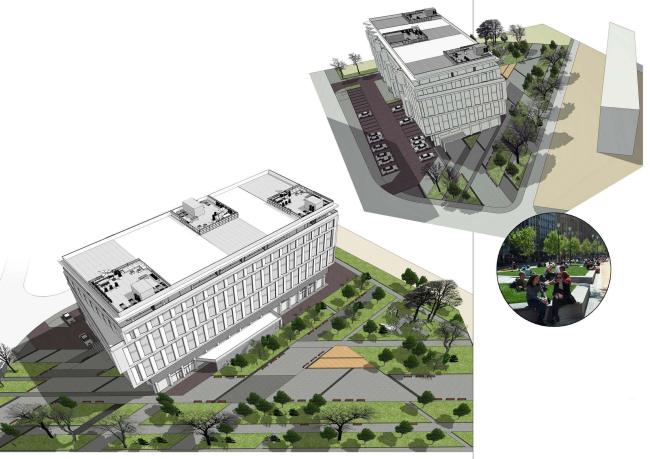
Preliminary architectural and planning concept of the multifunctional complex at the Vernadskogo Avenue © Т+Т Architects
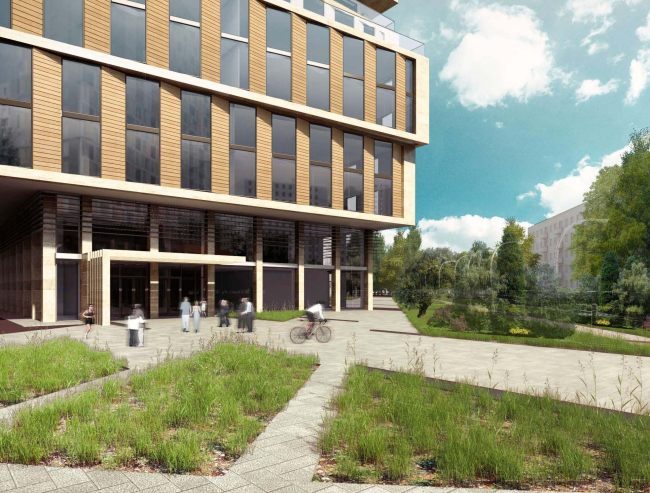
Preliminary architectural and planning concept of the multifunctional complex at the Vernadskogo Avenue © Т+Т Architects
It takes on an even more "outgoing" character thanks to the window apertures that are turned in respect to the surface if the facade. The architects had to make use of this technique because of the proximity to the already-mentioned residential tower - but while in the zone of visual discomfort they add onto the facade a dull plaque that is but occasionally broken by the concave bay windows, the other facades look like vertical "steps" that are formed by the geometric turnaround of the apertures in the wall surface in the whole. And, because in the case of new construction the number of floors can reach 8, the authors join the levels in pairs, accentuating the vertical rhythm of the building and enlarging its horizontal impression. Also important is the fact that the facade that us turned to the crossroads and to the metro station takes on an extra turning angle: the blocks of the floors shifted in respect to one another not only give the building some memorable tectonics but also create a friendly image (in the four-floor reconstruction, this role was played by the arch leading to the courtyard).
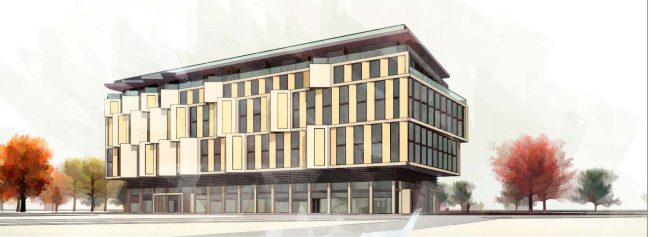
Preliminary architectural and planning concept of the multifunctional complex at the Vernadskogo Avenue © Т+Т Architects
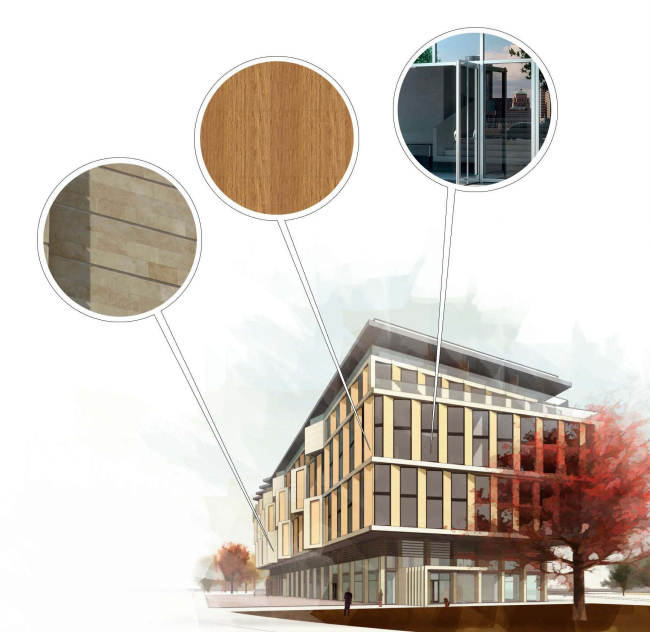
Preliminary architectural and planning concept of the multifunctional complex at the Vernadskogo Avenue © Т+Т Architects
Taking down the existing building, the architects keep its social function: the two lower levels are fully given to the shops, services, and the restaurant. And again, the main role is played by the coding of the facade - the volume is structured in such a way that one glance is enough to understand that it includes several functional blocks. The public floors are also extra-enhanced by ceiling-to-floor glazing while the upper levels are designed the same and only look different at the expense of their active tectonics. This was the architects' deliberate decision: combining in this case different finishing materials would have meant rendering this volume more noticeable and even garish which is bit exactly what a building inside the residential block needs.
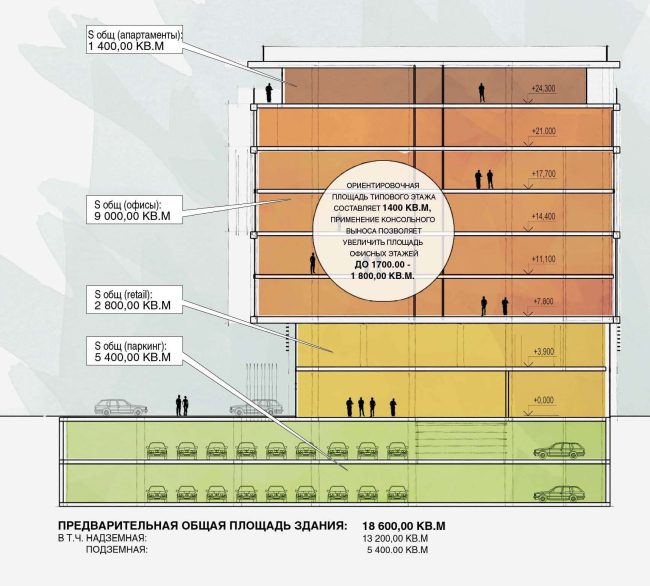
Preliminary architectural and planning concept of the multifunctional complex at the Vernadskogo Avenue © Т+Т Architects
Park Comes First
As was already said, in both of their concepts, "T+T Architects" paid close attention to organizing the adjacent territory, looking to implement as much as possible the principle of the architectural solutions of the complex itself and thus fully integrate the latter into the city environment. On the land site itself, due to its limited area, there was few opportunities for that - but it borders on two triangles of the city's land, and the architects proposed to use them for organizing, around the new center, a fully-fledged park with a recreation area, a playground, and a mini-stage for making concerts. The triangular shape of these sites came in incredibly handy - this landscaping supports and continues the theme of the architectural concept of the building with its shifted (or sunken-in, as in the first case) floors and averted windows (or the arch aperture).
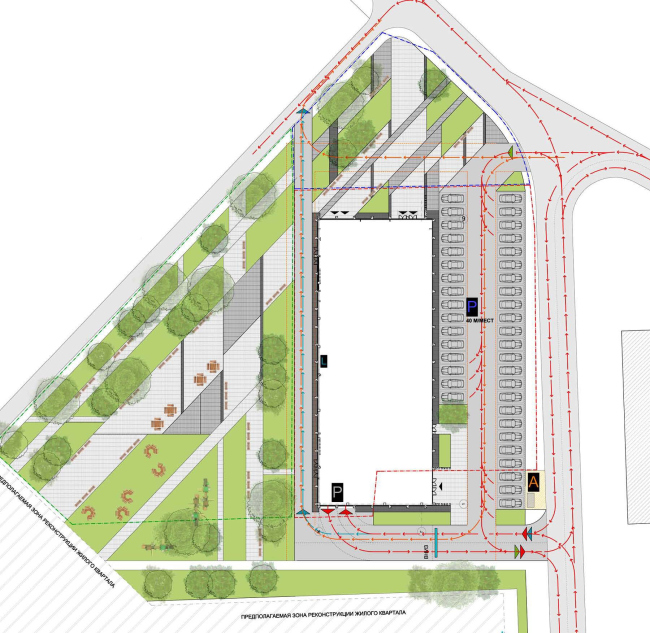
Preliminary architectural and planning concept of the multifunctional complex at the Vernadskogo Avenue © Т+Т Architects
As Sergey Trukhanov, the leader of "T+T Architects" shares, the customer, upon examining both concepts, ultimately opted for the new construction. Of course, in the first place, he was based on the question of the implementation costs that is always lower in the case of new construction. However, just as important was the fact that building a new project "from scratch" would allow, to a large extent, to take into consideration of the existing environment. In particular, the possibility to charge the project with a variety of public functions made the complex more useful to the local people, while the opportunity to completely separate them from the offices ensured convenience for everyone. But then again, the reconstruction option also had its indisputable strong points: the more stylish and well-balanced architectural solution, the availability of the courtyard and the compactness of the volume itself. "It was crucially important for us to work through both of the two scenarios of developing this site, studying not only the architectural but also the social and economic factors influencing its future, and in this sense this work became a very interesting experience that allowed the customer to justify his decision" - says Sergey Trukhanov.






